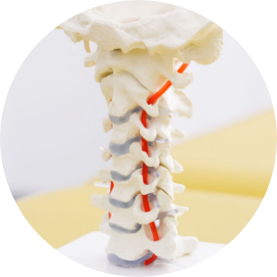What is the VNS analysis and why is it carried out?
The VNS analysis measures the autonomic nervous system (VNS) via heart rate variability (HRV). This consists of the sympathetic nervous system (tension nerve) and the parasympathetic nervous system (recovery or regeneration nerve) and acts as a kind of superordinate control center in the body, which controls and regulates subordinate processes and vital functions, such as blood pressure, breathing, heart rate, immune, hormonal and digestive systems and energy supply.
Originally, the VNS was there to prepare the body for fight or flight. Metaphorically speaking, this means that when a sabre-toothed tiger approached prehistoric man, the sympathetic nervous system was activated. This increased blood pressure, built up muscle tension and released sugar into the blood. The body was now in a state of extreme tension and high concentration. The parasympathetic nervous system was simultaneously shut down and with it all the systems that were not needed for fight or flight, such as the immune system, the hormone system and the digestive system. After the physical activity (fight or flight), the body was able to recover and regenerate because the parasympathetic nervous system was reactivated and the sympathetic nervous system was shut down. The cells could regenerate and the body could “recharge its batteries”.
Nowadays, the problem is that although numerous stress factors continue to affect the body (e.g. professional stress or private worries), physical activity often fails to materialize. If the stressful situations persist over a longer period of time, at some point it is no longer possible for the VNS to balance the parasympathetic nervous system (rest and relaxation) and the sympathetic nervous system (tension). The tension builds up in our body to create permanent stress, i.e. the sympathetic nervous system is constantly active. This constant stress causes blood pressure to rise and increases the sugar level in the blood, which is not used up by muscle movement. The sympathetic nervous system therefore puts all organs into tension, while the parasympathetic nervous system only runs on a low flame and thus also the digestive system, hormone system and immune system.
The VNS analysis now shows simply, quickly and scientifically recognized worldwide how well the autonomic nervous system (VNS) regulates and functions.
The VNS analysis is billed in our practice according to the fee schedule for alternative practitioners (GebüH).
What does a VNS analysis look like?
In the VNS analysis, the fluctuations in the heart rate at rest are analyzed, as these fluctuations reflect the activation state of the autonomic nervous system. The time interval between 520 heartbeats (RR intervals) is measured using a chest strap and the data is analyzed and graphically displayed in a software program.
If there is variability (different time intervals), the body can adapt well to internal and external stimuli. If no variability can be seen in the analysis, this means that the body can no longer adjust sufficiently or at all to internal and external stimuli. The body is then in a sympathetic starting position and the parasympathetic nervous system is partially in a state of rigidity.
The greater the variability measured in the heart rhythm, the more active the parasympathetic nervous system (recovery/regeneration). The less variability there is, the more active the sympathetic nervous system (fight/flight) is.
The HRV analysis, which is carried out at rest and in a seated position, should reveal a parasympathetic nervous system that is more active than the sympathetic nervous system because the measurement situation does not reflect a fight or flight situation.

What are the advantages of a VNS analysis?
After a few years, permanent regulation disorders of the VNS often lead to organ or functional disorders in the organism, e.g. the reactively increased blood pressure can develop into high blood pressure, the feeling of pressure in the upper abdomen may develop into chronic gastritis, nervous overload may develop into burn-out syndrome or manifest depression. Extensive studies also show that permanently impaired regulation of the autonomic nervous system is associated with a lower life expectancy.
This is why the VNS analysis is particularly important in the context of preventive care, as regulatory disorders can be detected and treated at an early stage before the organ or functional disorders actually occur.
In addition, the VNS analysis offers patients with pre-existing burnout syndrome and other psychovegetative disorders the opportunity to have an objectifiable (i.e. measurable) parameter for their illness determined. The recovery process of these patients can also be documented by means of control measurements following successful therapy.
The VNS analysis can also be used for other chronic diseases to determine the extent to which the current therapy leads to a balanced VNS or whether therapy optimization is still necessary.
When and for whom can the VNS analysis be used?
The VNS analysis is ideal for use in adults for:
- Prevention
- (Stress load) diagnostics
- Therapy control
Further information on the VNS analysis:

